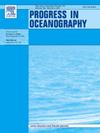Internal wave energetics and interactions with mesoscale structures in the Sicily Channel area
IF 3.6
3区 地球科学
Q1 OCEANOGRAPHY
引用次数: 0
Abstract
The Sicily Channel plays a crucial role in the general circulation of the Mediterranean Sea. However, the internal wave dynamics is still sparsely characterized in this area which is a hotspot for internal tides. Here, we benefit from a high-resolution model of the Mediterranean Sea with and without tidal forcings to study the synoptic internal wave dynamics in the Sicily Channel area as well as their interactions with the (sub)mesoscale field. We found strong semi-diurnal internal tide generation in the Sicily Channel and the Messina Strait. Diurnal internal tides are generated in the Sicily Channel, Pelagie Islands and the Malta Plateau, and are bottom-trapped because of their sub-inertial frequency. In contrast near-inertial waves are mainly generated in winter in the Tyrrhenian Sea and the northern Ionian Sea. We show that the geometry of the Sicily Channel prevents near-inertial wave to propagate through it. Near-inertial waves are trapped in anticyclonic eddies. In summer, we show that diurnal-inertial internal waves generated by the intense thermal breeze near coastal areas are trapped in anticyclonic eddies with an effective inertial frequency close to the diurnal frequency even far from 30°N of latitude. Implications for turbulence and mixing are discussed. We present indirect evidence of an enhanced forward energy cascade in the presence of tidal motions. Future work will focus on the impact of tidal motions on the energy cascade using a nested non-hydrostatic numerical simulation.
西西里岛海峡地区内波能量学及其与中尺度结构的相互作用
西西里海峡在地中海的环流中起着至关重要的作用。然而,该地区的内波动力学特征仍然较少,是内潮研究的热点。在这里,我们利用地中海有和没有潮汐强迫的高分辨率模式来研究西西里岛海峡地区的天气内波动力学及其与(亚)中尺度场的相互作用。在西西里岛海峡和墨西拿海峡发现强烈的半日内潮产生。日内潮产生于西西里岛海峡、佩拉吉群岛和马耳他高原,由于其次惯性频率而被困在海底。而在第勒尼安海和爱奥尼亚海北部,近惯性波主要在冬季产生。我们证明了西西里岛海峡的几何形状阻止了近惯性波通过它传播。近惯性波被困在反气旋涡流中。在夏季,我们发现沿海地区强烈的热风产生的日惯性内波被困在反气旋涡旋中,有效惯性频率接近日频率,即使远离纬度30°N。讨论了湍流和混合的意义。我们提出了在潮汐运动存在下增强的正向能量级联的间接证据。未来的工作将集中在潮汐运动对能量级联的影响上,使用嵌套的非流体静力数值模拟。
本文章由计算机程序翻译,如有差异,请以英文原文为准。
求助全文
约1分钟内获得全文
求助全文
来源期刊

Progress in Oceanography
地学-海洋学
CiteScore
7.20
自引率
4.90%
发文量
138
审稿时长
3 months
期刊介绍:
Progress in Oceanography publishes the longer, more comprehensive papers that most oceanographers feel are necessary, on occasion, to do justice to their work. Contributions are generally either a review of an aspect of oceanography or a treatise on an expanding oceanographic subject. The articles cover the entire spectrum of disciplines within the science of oceanography. Occasionally volumes are devoted to collections of papers and conference proceedings of exceptional interest. Essential reading for all oceanographers.
 求助内容:
求助内容: 应助结果提醒方式:
应助结果提醒方式:


